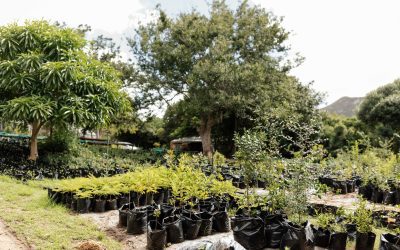
As a global community, we are plagued by a phenomenon known as ‘fast fashion’. This is a contemporary term that describes the rapid increase in both supply and demand for cheaply manufactured clothing. This philosophy of clothing production has been adopted by large retailers across the globe, such as Zara and Primark. Currently, the textile industry is driven by the consumer’s demand for new and trendy items of clothing, whilst a century ago, clothing would have been produced on a local scale, and for practical purposes.
Essentially, this sensation causes us to do three things:
- Dislike and therefore dismiss clothes that have fallen out of trend
- Incessantly buy new clothes, whether we need them or not
- Choose clothes made from cheap materials by brands that are not conscious of their environmental effects
Therefore, one might say that this global trend is leading to an insatiable demand for clothing.
The Unconscious Environmental Damage
In turn, the global fashion industry creates infinite harmful effects on the environment. However, the most pressing issues concerning the production and manufacturing of our clothes are the direct consequences it has on the global water system.
Take a look…
1) Water consumption
Shockingly, a recent report demonstrates that in 2015, the fashion industry consumed around 79 billion cubic meters of water. This is enough to fill 32 million Olympic-size swimming pools. Woah. What’s worse, this figure is estimated to increase by 50% by 2030. However, water is crucial for the dyeing and finishing processes of our garments.
It can take up to 2720 litres of water to make a simple T-shirt. That is absurd. Whilst cotton is a fabric favourite for T-shirts, it also needs vast quantities of water to grow. According to research conducted by the Water Footprint Network, in order to produce 1kg of cotton in India, at least 22,000 litres of water are required. This generates mass pressure on this valuable resource and has dire social and ecological consequences for developing countries. Furthermore, the Guardian claims that more than 100 million people in India do not have access to safe drinking water. Hence, it is crucial that we reconsider our demand for such an environmentally damaging fabric. If it were up to me, I would live in linen jumpsuits and floaty dresses, sort of Mamma Mia inspired….If you know, you know. But, that seems more like a fantasy given that I live in London, the rain centre of the universe.
What can we do about it?
Although you may not believe it, its actually easy peasy. Simply choose fibres with low water consumption. If you like linen, *cough cough like me* you’re in luck. Recycled fibres are also a good choice.
2) Water pollution
Many of the countries that produce our clothing garments experience high levels of untreated toxic wastewater. Unfortunately, textile factories are dumping this wastewater directly into local rivers. More so, this wastewater contains toxic substances such as lead, mercury, and arsenic. As you may know, these extremely harmful substances can have a devastating effect on marine life, as well as on the people living near these rivers. An example of this type of pollution is showcased in the 2016 documentary River Blue, which examines the destruction of our rivers and its effects on humanity. Eventually, the contamination will infiltrate the regional water system, and then the global water system.
What can we do about it?
Firstly, choose clothes that are made locally, and out of organic and natural fibres. I promise you, this is something that I have begun to do, and it has changed the way I purchase clothes now. Doing so, you support local businesses, and you are purchasing items of clothing are made with a loving hand. Often no two pieces are exactly the same and have intricate detailing. I’ll have you know that local purchases can also reduce extensive pollution in developing countries. So, purchasing local allows you to feel conscious and guilt-free about your clothing choices. What’s not to love?


Washing. Everyone hates washing. But, the environment also hates washing. Every time we wash a garment made out of synthetic materials, such as polyester or nylon, around 2,000 microfibres are released into the water. Eventually, they will spread through the water system, ending up in our rivers and oceans. When marine species eat the microfibres, that include teeny tiny pieces of plastic, it can fill their stomachs. Devastatingly, the microfibres never dissolve and some of the fibres even bind to harmful chemical pollutants, making them toxic. This process can lead to an increased rate of bioaccumulation in marine species. For those of you who aren’t scientists, or who didn’t make it past matric biology, like me, I’ll explain. Bioaccumulation is when a harmful chemical substance or pesticide, is absorbed by an organism at a faster rate than it can be excreted.
Essentially, our anthropogenic chemical production and accumulation can have dramatic effects on a species. For instance, in South Africa, it can be witnessed in the Humpback dolphins. This type of dolphin is classified as South Africa’s most vulnerable and endangered dolphin, as they receive large amounts of toxins in their systems. Unfortunately, their preference to live close to shore, and eat fish from rivers makes them vulnerable and more susceptible to our pollution. Fish that live in such habitats have already experienced the accumulation of chemicals, hence spreading chemicals on to the dolphins. Eventually, female dolphins create milk for their calves, which will be saturated with toxins. And so, unknowingly, mothers are putting the lives of their calves at risk.
So, we have basically introduced a system that injects plastic into our oceans, our marine life and eventually our own bodies. Yikes.
Right. So we’re not saying that you can’t buy any more synthetic rainbow coloured yoga leggings, or wash them after your sweaty Monday morning Bikram class. But you should try to be conscious as to what material they are made from and how often you are washing these synthetic materials.
What can we do about it?
Again, select clothing garments made from natural fibres. Only wash clothes when really necessary, or when it’s really really unbearably smelly. Then, when washing, choose low temperatures such as 30/40 degrees celcius.
In addition, textile waste is an ever growing issue. As clothing preferences change with every season and styles fade within days, clothing has essentially become disposable. Americans throw away around 13 million tons of textiles, which constitutes about 85% of their clothes, each year. Many synthetic fibres are plastic fibres, and are non-biodegradable. Therefore, we have created a huge ferris wheel of clothing waste accumulation, that doesn’t seem to be slowing.
So instead, let’s consciously try to buy less, buy better quality and wash less. Simple as.


I can understand that all of this information is a tad overwhelming. Now you are worried that every time you wash your clothes, a turtle’s stomach will be filled with micro-plastic. But, as a global community, we still have the power to make simple, daily changes in order to reduce our environmental damage.
Here’s a bit of inspiration….
Shop second-hand
This is the easiest tip, hence why it is the first one. I am truly obsessed with second-hand shops. It’s cheap, supports environmental sustainability and reduces textile waste. More so, it reduces manufacturing demands. In addition, second-hand shopping can also be applied to furniture, and other items too. For example, there is a new recycling establishment, ReTuna Återbruksgalleria, in Eskilstuna, Sweden. Interestingly, this facility is a combination of a recycling centre and a shopping mall. It seems noteworthy to add that customers can donate items that they no longer use, whilst also shopping for something new. Shopping second-hand is my idea of fun! It can lead you to vintage silk scarves, groovy 70s flares or some funky statement earrings. What’s not to love? Lisa Williams agrees.
— Lisa Williams
Patagonia’s Chief Product Officer
Like with fruit and veg, you can reduce large quantities of polluting gases when you buy from local stores in your home-town. Firstly, it saves transport and shipping fuel. Secondly, it promotes the growth of local businesses, which discourages the desire to purchase from large chain stores that are less sustainable. More so, by supporting these local businesses, you’re supporting fair-trade practices and strengthening local communities and livelihoods. On another note, it makes you a more conscious consumer, as local businesses are also more likely to consider their effects on the planet, and how they treat their workers. If you’re still stuck as how to find well made, ethical clothing pieces, look no further. Technology can consciously help you make smart AND ethical choices. My favourite new app, Good On You rates mainstream brands based on information available to the public. It rates brands from 1-5 on certain aspects of their sustainability and ethics, such as how it handles the people within the labour force, animals rights and the general impact on the planet. Even better, is that Emma Watson has become their new ambassador, and oh goodness, she is the true queen of ethical fashion. She constantly rocks high couture dresses made from recycled plastic and doesn’t look like a walking trash-can.
Take care when selecting your fabrics
As I hope to convert you into a conscious clothing consumer, it is vital to look at the label on your potential purchase. This is because different materials have different impacts on the environment.
- Synthetic fibres (polyester, acrylic, nylon) are used in the majority of our clothes. Not only are they made from fossil fuel, but are produced in countries that force people to work in horrific conditions. According to James Conca from FORBES, “Cheap synthetic fibres also emit gases like N2O, which is 300 times more damaging than CO2.”
- Cotton. Although cotton is a natural fibre, it is also a very environmentally damaging crop. Shockingly, in developing countries approximately 20,000 people die of cancer and miscarriages due to the chemicals sprayed on cotton, according to the World Health Organisation. On the contrary, organic cotton is made without any pesticides and chemicals. Generally speaking, clothing made from organic cotton is also fair-trade, where workers aren’t exposed to harmful chemicals.
- Instead, go for this natural fibre: Linen. Luckily this has become my personal eco-friendly favourite recently, and for many reasons. Firstly, it is a plant-based fabric made from flax. Amazingly, it can be grown on rough terrain, that is usually unsuitable for food production. Secondly, it is extremely durable. Lastly, whilst I’m living under the heat of the South African sun, I’m grateful to have found a fabric that is breathable, lightweight, absorbent, moth-resistant and cool… must I go on? Just one last thing, in terms of sustainability, it’s cultivation requires far less water and chemicals than cotton and it’s biodegradable. I think I’ve found the winner of the conscious consumer fabric award.


Whether this involves giving items of clothing to your younger sister, or to your little cousin. Even bringing your old clothes to a second-hand shop, potentially enables your unloved pieces to become someone else’s treasures. Simply by extending the life of clothes by three months of use per item, could lead to a 5-10% reduction in carbon, water and waste footprints. Amazing, don’t you think? However, I have to give you a brief word of caution when it comes to donating clothes. A survey carried out by the ‘The ABC’s War on Waste’, found that out of 36,700 participants, 82% of respondents had donated clothes to charity. However, only 53% had actually purchased an item of secondhand clothing. Therefore, this survey demonstrates that supply is overtaking demand, and so charity shops are slowly but surely become our dumping ground for cheap, low-quality clothing. In which case, instead of bringing ALL your old clothes to the charity shop, see the next tip.
Buy less and mend clothes.
Why not DIY any clothes that you no longer wear? Perhaps use frayed T-shirts as cleaning rags and old beach towels can be used for dog blankets. Seeing as they chew everything anyway.
Greenpop’s Innovative Restoration Methodology and the Uilenkraal Forest Restoration Project
Read more about Greenpop’s innovative restoration methodology and the Uilenkraal Forest Restoration Project.
.
From Fires to Flora: A Blueprint for Wildfire Resilience and Forest Restoration
Read more about the Garden Route Wildfires and how Greenpop helped restore the forest of Heartland, forging a more fire-ready ecosystem.
Beyond Trees: Restoring Biodiversity & Protecting the Endangered Cape Parrot
Beyond Trees: Restoring Biodiversity & Protecting the Endangered Cape Parrot11 SEPTEMBER, 2025Forests are vital to the health of our planet, but not all forests are created equal. As a report by the IUCN and Greenpop explains, "Primary forests store more carbon...
Greenpop Foundation NPC is a registered non-profit organisation. Registration Number (NPO): 151-411 NPO.




